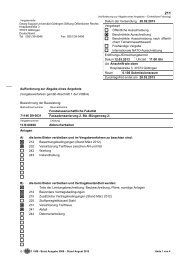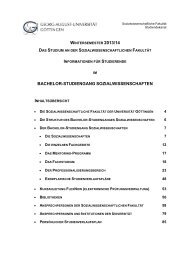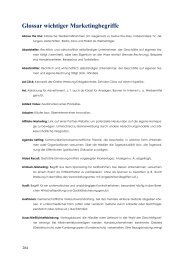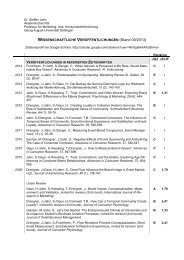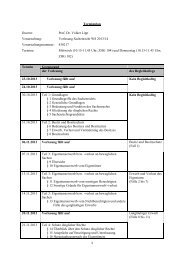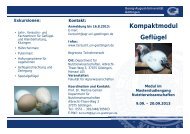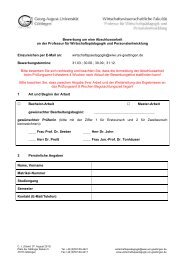India on Wheels: Past, Present and Future. Translated and ...
India on Wheels: Past, Present and Future. Translated and ...
India on Wheels: Past, Present and Future. Translated and ...
You also want an ePaper? Increase the reach of your titles
YUMPU automatically turns print PDFs into web optimized ePapers that Google loves.
<strong>Translated</strong> <strong>and</strong> Amended Versi<strong>on</strong> of “Motorisierung – Geschichte, Gegenwart und Zukunft Indiens“<br />
Masala: Newsletter Virtual Library South Asia, No. 3, July 2013<br />
<str<strong>on</strong>g>India</str<strong>on</strong>g> <strong>on</strong> <strong>Wheels</strong>: <strong>Past</strong>, <strong>Present</strong>, <strong>and</strong> <strong>Future</strong> *<br />
Stefan Tetzlaff, CeMIS, University of Göttingen<br />
Specialized research interests in the humanities <strong>and</strong> social sciences are not always<br />
readily underst<strong>and</strong>able by the wider public. In <strong>on</strong>e sense, this is unavoidable, since<br />
scholars must develop their own terms <strong>and</strong> language to carry out deep research <strong>and</strong><br />
talk with each other about their findings. But historians <strong>and</strong> social scientists especially<br />
should also strive to present their areas of research in an accessible way to audiences<br />
who may be interested but not as familiar with specialized language. With this in<br />
mind, I attempt here to describe what I have been working <strong>on</strong> since 2010 under the<br />
guidance of Professor Ravi Ahuja in the c<strong>on</strong>text of the DFG-funded research project<br />
„The Motorisati<strong>on</strong> of the ‚Mufassil’: Automobile Traffic <strong>and</strong> Social Change in Rural<br />
North <str<strong>on</strong>g>India</str<strong>on</strong>g>, c. 1925-70“. The project deals mainly with ec<strong>on</strong>omic, political <strong>and</strong> social<br />
aspects of motor transport in a few regi<strong>on</strong>s in <str<strong>on</strong>g>India</str<strong>on</strong>g> since the late col<strong>on</strong>ial period.<br />
Here, motor vehicles were not merely tools used by various groups; they also stood in<br />
a reciprocal relati<strong>on</strong>ship with <str<strong>on</strong>g>India</str<strong>on</strong>g>’s politics, ec<strong>on</strong>omy <strong>and</strong> society at the time. The<br />
project pays attenti<strong>on</strong> to why <strong>and</strong> in which regi<strong>on</strong>s motor transport developed in ways<br />
that were similar to Europe or the USA <strong>and</strong> where the development trajectories were<br />
completely different.<br />
Instead of delving into the precise arguments of my project, I would like to address<br />
here some other issues that came up in my research. These things were <strong>and</strong> are not<br />
central to my main project but might be of a particular public interest that is<br />
c<strong>on</strong>nected to the fact that a major part of the ec<strong>on</strong>omies of industrialized countries is<br />
* My sincere thanks to J<strong>on</strong> Keune for helpful comments. Views expressed remain mine al<strong>on</strong>e. <br />
1
<strong>Translated</strong> <strong>and</strong> Amended Versi<strong>on</strong> of “Motorisierung – Geschichte, Gegenwart und Zukunft Indiens“<br />
Masala: Newsletter Virtual Library South Asia, No. 3, July 2013<br />
built <strong>on</strong> automobile producti<strong>on</strong> <strong>and</strong> export. The German ec<strong>on</strong>omy is a good example.<br />
Currently, several German manufacturers of mid- <strong>and</strong> upper-range automobiles such<br />
as Volkswagen <strong>and</strong> Daimler are showing significant interest in the growing <str<strong>on</strong>g>India</str<strong>on</strong>g>n<br />
automotive market. This is the case even despite the relative stagnati<strong>on</strong> of recent sales<br />
figures in <str<strong>on</strong>g>India</str<strong>on</strong>g>, when compared to the much more important Chinese market.<br />
Historically, Daimler especially played a very active role in <str<strong>on</strong>g>India</str<strong>on</strong>g>’s<br />
automotive sector, for example by cooperating with the <str<strong>on</strong>g>India</str<strong>on</strong>g>n company Tata <strong>on</strong> the<br />
manufacture of trucks between the 1950s <strong>and</strong> 1970s as well as <strong>on</strong> the producti<strong>on</strong> of<br />
cars during the 1990s <strong>and</strong> early 2000s.<br />
Picture 1. Advertisements for Tata-Mercedes-Benz Trucks. From: “Motor Transport“, Journal of the All-<str<strong>on</strong>g>India</str<strong>on</strong>g> Motor<br />
Transport Uni<strong>on</strong> C<strong>on</strong>gress, January 1960 (left) <strong>and</strong> October 1958<br />
2
<strong>Translated</strong> <strong>and</strong> Amended Versi<strong>on</strong> of “Motorisierung – Geschichte, Gegenwart und Zukunft Indiens“<br />
Masala: Newsletter Virtual Library South Asia, No. 3, July 2013<br />
Daimler also had a five per cent stake in Tata Motors until 2008 <strong>and</strong> c<strong>on</strong>tinues to<br />
maintain several producti<strong>on</strong> sites in <str<strong>on</strong>g>India</str<strong>on</strong>g>, al<strong>on</strong>g with a research <strong>and</strong> development<br />
department in Bangalore that provides technical expertise for the company’s entire<br />
global operati<strong>on</strong>s.<br />
Recent decades have witnessed a huge expansi<strong>on</strong> of producti<strong>on</strong> in industrialising<br />
countries, driven by their various special ec<strong>on</strong>omic programmes. Regardless of<br />
whether or not <strong>on</strong>e counts <str<strong>on</strong>g>India</str<strong>on</strong>g> as being am<strong>on</strong>g the already well-established<br />
ec<strong>on</strong>omic powers, the country’s automotive sector certainly has not c<strong>on</strong>tributed to the<br />
country’s ec<strong>on</strong>omic upsurge in a very significant <strong>and</strong> major way. It is true that a range<br />
of political ideas <strong>and</strong> initiatives existed in this directi<strong>on</strong>, for example the recurrent<br />
appearance of the discussi<strong>on</strong> around a low-cost small car for the <str<strong>on</strong>g>India</str<strong>on</strong>g>n populace.<br />
These discussi<strong>on</strong>s were, however, often protracted <strong>and</strong> marked by great political <strong>and</strong><br />
ec<strong>on</strong>omic uncertainties. It was <strong>on</strong>ly in 1981, with the founding of the still-existing <strong>and</strong><br />
very successful joint venture between Maruti <strong>and</strong> Suzuki that these plans were really<br />
implemented. During the first twenty years, <strong>on</strong>ly the upper <strong>and</strong> middle classes could<br />
afford the cooperati<strong>on</strong>’s motor vehicles, but the middle class has exp<strong>and</strong>ed immensely<br />
since the 1990s. In additi<strong>on</strong>, the highly diversified companies Tata <strong>and</strong> Mahindra<br />
were able to develop as real success stories in the automotive sector without state<br />
interventi<strong>on</strong>. Both companies produce private <strong>and</strong> commercial vehicles of different<br />
sizes <strong>and</strong> for different purposes. In 1998, Tata began producing the Indica, the first<br />
car to be fully produced within <str<strong>on</strong>g>India</str<strong>on</strong>g>; it has been successful in the domestic market<br />
with a growing range of products ever since. But the company also exp<strong>and</strong>s overseas,<br />
both with its own br<strong>and</strong>s <strong>and</strong> through acquisiti<strong>on</strong>s of high-value br<strong>and</strong>s such as Jaguar<br />
<strong>and</strong> L<strong>and</strong> Rover in 2008.<br />
3
<strong>Translated</strong> <strong>and</strong> Amended Versi<strong>on</strong> of “Motorisierung – Geschichte, Gegenwart und Zukunft Indiens“<br />
Masala: Newsletter Virtual Library South Asia, No. 3, July 2013<br />
Overall, however, the <str<strong>on</strong>g>India</str<strong>on</strong>g>n political <strong>and</strong> ec<strong>on</strong>omic leadership has not tried to<br />
establish the automobile industry as a key industry al<strong>on</strong>g the lines of what was d<strong>on</strong>e<br />
in Europe or the USA, but rather stimulated other sectors in an attempt to support the<br />
overall ec<strong>on</strong>omy. It is important to ask whether this should be really the model to<br />
emulate for the <str<strong>on</strong>g>India</str<strong>on</strong>g>n political <strong>and</strong> ec<strong>on</strong>omic system at all, especially since<br />
developments in Europe <strong>and</strong> the USA seemingly suggest that promoting the car<br />
industry as a central ec<strong>on</strong>omic feature might be outdated. The <strong>on</strong>ly alternative,<br />
however, would be to import mid- <strong>and</strong> high-priced cars in great numbers also in<br />
future <strong>and</strong> hence to cause a sizable trade balance deficit in this regard. This is not to<br />
say that <str<strong>on</strong>g>India</str<strong>on</strong>g>’s development path in this regard has to look exactly the same as in the<br />
established industrialised countries where the internal combusti<strong>on</strong> engine would not<br />
survive without their energy policies <strong>on</strong> fossil fuel. Positive ec<strong>on</strong>omic effects aside, a<br />
more efficient <strong>and</strong> cost-effective producti<strong>on</strong> of automobiles in <str<strong>on</strong>g>India</str<strong>on</strong>g> could also<br />
incorporate new <strong>and</strong> badly needed mobility c<strong>on</strong>cepts <strong>and</strong> envir<strong>on</strong>mental aspects in<br />
automotive design <strong>and</strong> development. Manufacturers from industrial countries have<br />
barely begun to c<strong>on</strong>sider taking those steps. The necessary technological know-how<br />
<strong>and</strong> corporate capital for such innovati<strong>on</strong>s, of course, has existed in <str<strong>on</strong>g>India</str<strong>on</strong>g> for a l<strong>on</strong>g<br />
time. They would <strong>on</strong>ly have to be channelled correctly through the implementati<strong>on</strong> of<br />
new <strong>and</strong> strict policies that address higher educati<strong>on</strong>, research <strong>and</strong> technology.<br />
The increasing motorisati<strong>on</strong> of <str<strong>on</strong>g>India</str<strong>on</strong>g> implies not <strong>on</strong>ly positive ec<strong>on</strong>omic effects, but<br />
also significant risks. One of them is the problem of transport in <str<strong>on</strong>g>India</str<strong>on</strong>g>’s major cities,<br />
which have exhibited a large <strong>and</strong> growing motor vehicle fleet for several decades<br />
already. Increasing traffic <strong>and</strong> envir<strong>on</strong>mental problems led governmental authorities<br />
in the 1980s to introduce car sharing practices as well as time-based restricti<strong>on</strong>s <strong>on</strong><br />
inner-city motor vehicle use, although with little success. (Interview Dr. P.S.<br />
4
<strong>Translated</strong> <strong>and</strong> Amended Versi<strong>on</strong> of “Motorisierung – Geschichte, Gegenwart und Zukunft Indiens“<br />
Masala: Newsletter Virtual Library South Asia, No. 3, July 2013<br />
Pasricha). Motor vehicle numbers have grown steadily since the 1990s, <strong>and</strong> this<br />
growth is accelerating. This is borne out by the fact that more <strong>and</strong> more individuals<br />
<strong>and</strong> families want to <strong>and</strong> can afford motor vehicles for pers<strong>on</strong>al transport. This trend<br />
also suggests that customers are mostly interested in upgrading their means of<br />
transport towards bigger, more expensive <strong>and</strong> prestigious vehicles.<br />
Tata’s highly acclaimed introducti<strong>on</strong> of the small car Nano in 2009 is the perfect<br />
example of this trend. Both the company <strong>and</strong> the public put high hopes in the vehicle<br />
selling in cities <strong>and</strong> across the country, not least with respect to solving traffic<br />
problems due to its smaller size <strong>and</strong> lower emissi<strong>on</strong>s <strong>and</strong> allowing more people to<br />
have their own cars. But we can now say the product <strong>and</strong> c<strong>on</strong>cept have largely failed.<br />
Sales figures remained minuscule throughout despite having a low price of roughly<br />
1,500 Euros, <strong>and</strong> the most recent news is that sales have collapsed by eighty per cent<br />
(article in Financial Express). There are probably several reas<strong>on</strong>s for this. Tata itself<br />
already points to <strong>on</strong>e such reas<strong>on</strong> with the slogan „Move up to Sedan Class“ in an<br />
advertisement campaign for the Indica Vista running in 2012.<br />
Picture 2. Advertising campaign for the Indica Vista, http://www.network2media.com/, 24 June 2013<br />
5
<strong>Translated</strong> <strong>and</strong> Amended Versi<strong>on</strong> of “Motorisierung – Geschichte, Gegenwart und Zukunft Indiens“<br />
Masala: Newsletter Virtual Library South Asia, No. 3, July 2013<br />
The potential shift of customers toward bigger vehicles that fulfil the middle class’<br />
ideals <strong>and</strong> c<strong>on</strong>cepts of what a car should be seems to have taken place rather quickly,<br />
<strong>and</strong> companies have already adjusted their product range <strong>and</strong> sales policy<br />
accordingly. This trend is also reflected in the design <strong>and</strong> c<strong>on</strong>ceptualisati<strong>on</strong> of<br />
automobiles. Most <str<strong>on</strong>g>India</str<strong>on</strong>g>n c<strong>on</strong>sumers seem to prize technical sophisticati<strong>on</strong> <strong>and</strong><br />
driving pleasure to a lesser extent than European car owners, <strong>and</strong> instead are more<br />
interested in the total package <strong>and</strong> especially in a comfortable <strong>and</strong> lush interior design<br />
(Interview Hormazd Sorabjee).<br />
But the increasing tendency in terms of quantity <strong>and</strong> quality towards changing to<br />
individual mobility <strong>and</strong> bigger car models will raise serious problems <strong>and</strong> challenges.<br />
For example, urban areas now witness much greater traffic that entails time<br />
c<strong>on</strong>suming <strong>and</strong> stressful traffic jams. Problems with CO2-emmisi<strong>on</strong>s <strong>and</strong> the lack of<br />
space are bound to increase immensely over the next decades. But also smaller cities<br />
<strong>and</strong> the countryside already possess a solvent <strong>and</strong> growing clientele for automobiles<br />
who will carry the motorisati<strong>on</strong> process into this area in future. This tendency will<br />
grow over the next years <strong>and</strong> decades, as numerous <strong>and</strong> exp<strong>and</strong>ing programmes in<br />
areas such as highway, road c<strong>on</strong>structi<strong>on</strong>, <strong>and</strong> logistics extend well-c<strong>on</strong>nected routes<br />
between major cities to an increasingly sophisticated <strong>and</strong> comprehensive nati<strong>on</strong>al<br />
road network.<br />
If <strong>on</strong>e were to extrapolate based <strong>on</strong> the current use of fossil fuels in the transport<br />
sector to the development expected to take place in countries such as <str<strong>on</strong>g>India</str<strong>on</strong>g> <strong>and</strong> China,<br />
humans <strong>and</strong> the envir<strong>on</strong>ment in these countries <strong>and</strong> bey<strong>on</strong>d will probably have to face<br />
serious problems. Exhaust gas emissi<strong>on</strong>s from motor traffic in <str<strong>on</strong>g>India</str<strong>on</strong>g>n cities already<br />
have reached critical levels already <strong>and</strong> often surpass maximum permissible values<br />
especially during the winter m<strong>on</strong>ths (talk Parikshit Ghosh). It will be important in this<br />
6
<strong>Translated</strong> <strong>and</strong> Amended Versi<strong>on</strong> of “Motorisierung – Geschichte, Gegenwart und Zukunft Indiens“<br />
Masala: Newsletter Virtual Library South Asia, No. 3, July 2013<br />
respect to see how discussi<strong>on</strong>s <strong>on</strong> climate justice <strong>and</strong> emissi<strong>on</strong>s proceed in <str<strong>on</strong>g>India</str<strong>on</strong>g> <strong>and</strong><br />
other countries in relati<strong>on</strong> to global instituti<strong>on</strong>s. The political <strong>and</strong> intellectual<br />
leadership in countries like <str<strong>on</strong>g>India</str<strong>on</strong>g> currently seems to be inclined to dem<strong>and</strong> a per<br />
capita c<strong>on</strong>sumpti<strong>on</strong> of CO2-emissi<strong>on</strong>s in order to have an ec<strong>on</strong>omic development<br />
similar to what industrial countries experienced over the last half decade or so. This is<br />
also based <strong>on</strong> the assumpti<strong>on</strong>s that hitherto unfulfilled development potentials are a<br />
fallout of the l<strong>on</strong>g col<strong>on</strong>ial past <strong>and</strong> that these potentials must be realized now no<br />
matter what. The positi<strong>on</strong>s of various political actors in this matter seem deadlocked.<br />
Important further questi<strong>on</strong>s remain to be answered: what will the motorisati<strong>on</strong> of<br />
<str<strong>on</strong>g>India</str<strong>on</strong>g> look like in future? Will it be a major c<strong>on</strong>cern for actors <strong>and</strong> instituti<strong>on</strong>s at the<br />
nati<strong>on</strong>al <strong>and</strong> global level at all? What happens with <strong>and</strong> in <str<strong>on</strong>g>India</str<strong>on</strong>g>n cities if the <str<strong>on</strong>g>India</str<strong>on</strong>g>n<br />
populace starts favouring mobility c<strong>on</strong>cepts similar to those Germans in particular<br />
have practiced since the 1950s for commuting to work or in their leisure time? Will<br />
<str<strong>on</strong>g>India</str<strong>on</strong>g> see mega traffic jams during holidays <strong>and</strong> festivals similar to the packed<br />
highways that Germany <strong>and</strong> other countries across Europe see during their summer<br />
holidays? Or will the <str<strong>on</strong>g>India</str<strong>on</strong>g>n transportati<strong>on</strong> sector develop in a completely different<br />
directi<strong>on</strong>? These will be important questi<strong>on</strong>s while motor vehicle use is almost bound<br />
to increase drastically.<br />
7
<strong>Translated</strong> <strong>and</strong> Amended Versi<strong>on</strong> of “Motorisierung – Geschichte, Gegenwart und Zukunft Indiens“<br />
Masala: Newsletter Virtual Library South Asia, No. 3, July 2013<br />
Research Material<br />
Websites of the companies Tata, Maruti-Suzuki, Mahindra, Daimler, Volkswagen <strong>and</strong><br />
the German Federal Government<br />
„Tata Motors slashes Nano producti<strong>on</strong>, signals mega slowdown“, Financial Express, 5<br />
March 2013, http://www.financialexpress.com/news/sharp-cut-in-nano-outputsignals-mega-slowdown/1083104<br />
Interview with Dr. P.S. Pasricha, former Police Commissi<strong>on</strong>er, Mumbai <strong>and</strong> Director<br />
General of Police, Maharashtra, 3 September 2012<br />
Interview with Hormazd Sorabjee, Editor of Autocar <str<strong>on</strong>g>India</str<strong>on</strong>g>, <str<strong>on</strong>g>India</str<strong>on</strong>g>’s foremost<br />
Automobile Magazine, Mumbai, 27 August 2012<br />
Parikshit Ghosh, Delhi School of Ec<strong>on</strong>omics, <strong>Present</strong>ati<strong>on</strong> „C<strong>on</strong>tested L<strong>and</strong> <strong>and</strong><br />
Polluted Cities: Some Dilemmas of <str<strong>on</strong>g>India</str<strong>on</strong>g>’s Development”, CeMIS-Colloquium, 12<br />
June 2013<br />
"Motor Transport", Journal published by the All-<str<strong>on</strong>g>India</str<strong>on</strong>g> Motor Transport Uni<strong>on</strong><br />
C<strong>on</strong>gress, New Delhi since 1936<br />
8






